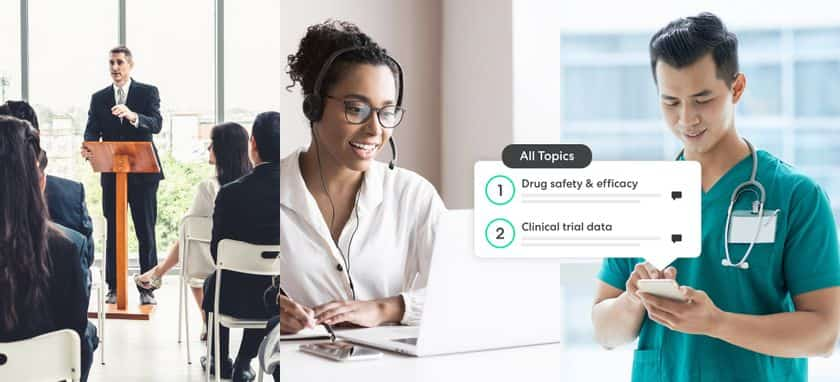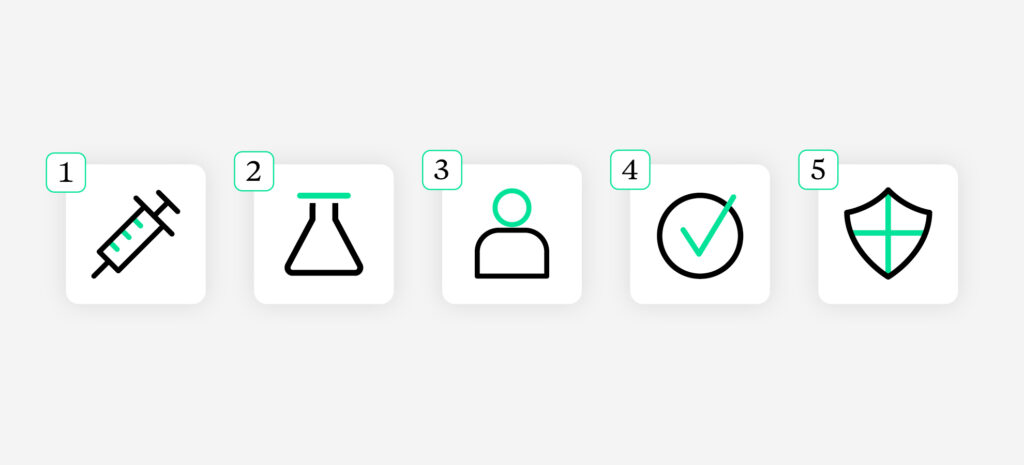As of early June, nearly two billion doses of coronavirus vaccines have been administered – stunning progress from where the world stood just a year ago, already months into the pandemic. While the progress is encouraging, there are still stark differences in vaccination rates for different countries, with some yet to report administering any vaccines at all. Still, official travel restrictions are set to loosen or lift, and vaccinated people feel increasingly comfortable traveling for work or leisure. These factors will dictate changes to life science virtual engagement strategies.
Pharmaceuticals and medical device are global industries, and international travel may still be complicated or subject to change during the next six months. Even regional trips could be challenging – COVID-19 variants are a factor, as is personal reluctance to travel based on health status or case counts in different destinations.
So how do pharmaceutical and medical device teams create certainty in this uncertain world? We know from our own research that about 70% of medical affairs, clinical, and commercial teams say they’re likely to continue conducting virtual engagements even as travel resumes. Based on this sentiment and conversations with our own clients, we believe that life science organizations will approach the latter half of 2021 by cautiously re-incorporating some face-to-face activity while placing hybrid or asynchronous collaboration at the core of their engagement strategies.
To do this effectively, life science teams must be able to answer three key questions.
How do you define virtual engagement?
In our survey, responses indicated that many in the life science industry consider virtual and Zoom (or equivalent video conference platforms) to be synonymous. During the pandemic, workdays grew longer and meetings more frequent – so it’s no wonder that most survey respondents reported fatigue as the primary challenge of virtual meetings. Expanding the definition of virtual to include all types of hybrid engagements is a necessary step in moving forward with an effective strategy.
Teams that use asynchronous discussions to enable deep work and reduce burnout see increased productivity and more thoughtful responses in a format that’s inclusive, supportive, and accommodating to colleagues located all over the world. A cohesive virtual engagement strategy that includes asynchronous discussions supplemented by real-time virtual and in-person elements provides compelling benefits to pharmaceutical and medical device teams – something we’ve seen across thousands of engagements custom-designed to meet each client’s needs.
What is the right mix of face-to-face and virtual?
Pandemic travel restrictions and lockdown forced everyone into a virtual-only situation overnight, but the truth is that life science teams were increasingly using hybrid virtual engagement prior to 2020. Asynchronous discussions, punctuated by real-time virtual interactions such as webcasts, enable better stakeholder engagement and more relevant insight for better decision making. It’s for this reason that most pharmaceutical companies will move forward with a virtual-first strategy.
For this approach to be successful, teams need to understand where virtual environments excel and where in-person interaction is a better fit. In working with our clients, we find that developing competency across all three types of engagement – face-to-face, live virtual, and asynchronous – gives teams the most flexibility and the best results.
Earlier this year, we described what a completely hybrid engagement approach looks like, from in-person events with streaming or asynchronous elements to completely over-time discussions that take place over a couple of weeks. Deciding what mix is best for your team, and for the audiences you want to engage, is the first step in building an engagement strategy that’s future-proofed against uncertainty.
What do you need to execute your plan?
A forward-looking virtual-first strategy requires a goal-oriented examination of what your team is hoping to achieve, whether that’s more actionable insights, accelerating timelines, KOL identification, or all of the above and more. When you know your destination, you’re more likely to understand the best way to get there.
Next, think about your audience. KOLs are likely at least somewhat eager to resume travel and the peer-to-peer interaction that goes along with it. But not every KOL will attend every meeting, and their time will be in high demand as in-person meetings become safer and more common again. Consider how you can prioritize their needs while still meeting your own. Many clients tell us they’ll be increasing the frequency of virtual touchpoints throughout the year – a great way to strengthen relationships without interrupting already busy schedules.
Finally, consider how you might change up your meeting format or content to better suit an asynchronous or hybrid approach. In-person advisory board meetings might mean a few hours of conversation around a conference table, with questions and related data presented on a screen. In an asynchronous environment, you’d want to roll out groups of questions every few days to allow more focused work and avoid fatigue, and you might include pre-recorded videos or reference documents for participants to read and consider on their own time.
Developing these competencies isn’t about starting from scratch – it’s about rethinking insights management in a way that makes data even more relevant and powerful. When we guide clients through the process of designing productive virtual engagements, we like to think we’re freeing them to focus on their area of expertise without worrying about logistics or roadblocks. Virtual engagement simply expands the notion of what’s possible in terms of reaching more audiences, more cost- and time-effectively, to achieve deeper and more actionable insights.
Hear from Within3 CEO Lance Hill about how a hybrid virtual engagement strategy will work as face-to-face interaction resumes – watch the video.






